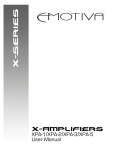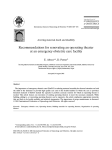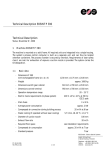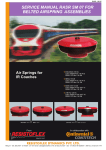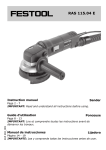Download Emotiva 10 User's Manual
Transcript
2 Emotiva Ultra Series Subwoofers – Table of Contents SAFETY PRECAUTIONS 4 NEC (National Electrical Code) Standards A Note for the Cable Television (CATV) Installer Antenna Grounding Outside the House 6 6 6 Thank You For Your Purchase 7 Emotiva Ultra Subwoofers Overview and Features 8 Specifications 8 Unpacking Your Ultra Subwoofer Inventory 9 9 Component Descriptions and Diagram 10 Back Panel Controls Descriptions and Diagrams 11 Connection Considerations 13 Connecting to a Stereo Preamplifier (with Diagram) 13 Using an Ultra Subwoofer in a Multi‐Channel System (Diagram) 14 Placement Tips (with Diagram) 15 Using Low Pass Filters and Setting the Crossover Frequency 16 Setting the Phase Control 16 Using Multiple Subwoofers in a Multi‐Channel System 17 Troubleshooting Guide No Sound Turn‐on and Turn‐off Thumps “Hum” Noises Other Probable Causes of Noise Problems with the whole A/V System 18 18 18 18 19 19 Limited Warranty 20 Service Assistance 20 Emotiva Disclosure 20 3 SAFETY PRECAUTIONS Read this User’s Guide thoroughly before attempting to install and configure your Ultra Subwoofer. All the safety and operation instructions should be read before any operation of the component(s) begin. After successful installation and configuration of the Subwoofer, be sure to retain this manual in a safe place for future reference. All warnings on the Subwoofer and in this Operation Manual should be followed. Safety is a key component to a long lasting, trouble free installation. The vast majority of the safety precautions are simply common sense. If you don't feel comfortable performing the installation of audio/video entertainment equipment, it is advised that you seek the services of a qualified installation professional. NEVER use Ultra Subwoofers near water, such as a bathtub, washbowl, kitchen sink, laundry tub, in a wet basement, or near a swimming pool, etc. There is a risk of electric shock to your body and permanent damage to the equipment. Electric shock may result in permanent bodily injury or death. This Subwoofer should be installed in a location which provides adequate ventilation. The Subwoofer should be situated away from heat sources such as radiators or other heat producing devices. Ultra Subwoofers should be connected only to a power supply as described in this Operation Manual or shown on the label located on the back of the subwoofer. The power cord should be routed so that it avoids high foot traffic areas; and, placement of the power cord should avoid locations where heavy items may be placed upon or against it. Special attention should be given where the power cord will plug into the wall outlet, convenience receptacles, and the point where the power cord attaches to the subwoofer. The power cord of the subwoofer should be unplugged from the outlet when unused for a long period of time. Never spray liquids directly onto the component. Care should be taken so that small objects do not fall into the inside of the Subwoofer. The following situatio ns require your Ultra Subwoofer is serviced only by qualified service personnel: • The power‐supply cord or the plug has been damaged; or • Objects have fallen, or liquid has spilled into the component; or • The Ultra Subwoofer has been exposed to rain; or • The Ultra Subwoofer does not appear to operate normally or exhibits a marked change in performance; or • The Ultra Subwoofer has been dropped, or its enclosure is damaged. The user should not attempt to service the Ultra Subwoofer beyond the means described in this Operation Manual. All other servicing should be referred to Emotiva's service personnel. 4 To prevent electric shock, do not use this polarized plug with an extension cord, receptacle or other outlet unless the blades can be fully inserted to prevent blade exposure. Grounding or Polarization — Precautions should be taken so that the grounding or polarization means of the component is not defeated. This apparatus does not exceed the Class A /Class B (whichever is applicable) limits for radio noise emissions from digital apparatus as set out in the radio interference regulations of the Canadian Department of Communications. For questions regarding service, please contact: 877‐EMO‐TECH (877‐366‐8324) | [email protected] | www.emotiva.com WARNING: TO REDUCE THE RISK OF FIRE OR ELECTRIC SHOCK, DO NOT EXPOSE THIS APPLIANCE TO RAIN OR MOISTURE. CAUTION: TO PREVENT ELECTRIC SHOCK, MATCH WIDE BLADE OF PLUG TO WIDE SLOT, FULLY INSERT. 5 NEC (National Electrical Code) Standards A Note for the Cable Television (CATV) Installer This reminder is to call the CATV system installer’s attention to Article 820‐40 of the NEC that provides guidelines for proper grounding and in particular, specifies that the cable ground shall be connected to the grounding system of the building as close to the point of cable entry as practical. Antenna Grounding Outside the House If an outside antenna is connected to the receiver, be sure the antenna system is grounded so as to provide some protection against voltage surges and built‐up static charges. Article 810 of the National Electrical Code, ANSI/NFPA 70, provides information with regard to proper grounding of the lead‐in wire to an antenna‐discharge unit, connection to grounding electrodes, and requirements for the grounding electrode. Always observe proper antenna or satellite dish grounding techniques. When lightning strikes there is always the possibility that your antenna or dish (mounted high on the roof) can become a conduit for lightning and electrically damage any equipment to which it’s connected. Additionally, proper grounding offers safety to the people using the audio/video system in the event of an electrical problem. 6 Thank You for your Purchase! We’re happy you chose Emotiva Audio! We believe our products set a new standard for performance and value. Ultra Subwoofers, while affordable and simple to set up and use, are constructed from high quality components and offer audiophile level sound quality. They incorporate advanced technologies and design and will transform you music and movie experience by adding impact, excitement, and depth. Our staff is a phone call away, ready to assist you if needed. We stand behind our products 100%, and we know that earning your trust and ongoing support requires on our continued commitment to excellence every day. Emotiva started with an idea – audio enthusiasts and engineers building gear that satisfied their own high standards, and sharing it with fellow music and movie lovers, with no one in the middle. We have a simple vision; bring to you, our customers and friends, the best possible gear at the lowest prices. We wish you many hours of enjoyment with your new Emotiva purchase. Welcome to the family! Dan Laufman, President, Emotiva Audio Corporation 7 Emotiva Ultra Subwoofers Overview and Features Ultra Subwoofers are designed to add dynamic, solid bass to your home theater and music listening experience, while maintaining accurate, extended frequency response. All Emotiva loudspeakers are extremely efficient, allowing you to maximize power and performance in any listening situation. The compact cabinet size makes the Ultra Subs an ideal choice for systems employing multiple subwoofer setups. Key features of the Ultra Subs: • High efficiency Class D power amplifiers with exceptional dynamic headroom • High performance cast frame woofers with massive magnetic motor assembly • Long throw high BL woofer design • Proprietary para‐aramid fiber blend cone and dust cap for accurate low frequency response • Heavy‐duty butyl rubber surround • Sealed, front firing cabinet for tight and extended low end • Sophisticated dynamics processing for optimized system performance • Elegant soft clip limiting • Interchangeable aluminum spikes or non‐marring rubber feet • XLR/Balanced and RCA/Unbalanced input connections • Rotary controls for Crossover Frequency, Volume, and Phase • Compact, manageable cabinet size • Auto turn circuitry • Removable grills Specifications Power Output: USub10‐ 300 watts Usub12‐500 watts Typical In‐Room Frequency Response: USub10: 25Hz‐200Hz Usub12: 22Hz‐200Hz Typical In‐Room SPL: USub10: 107‐110db Usub12: 109‐112db Balanced Input: 3V Unbalanced Input: 1.25V Phase Adjustment: 0‐180 degrees X Over: 50‐150Hz (24db per octave) Dimensions: USub10: 12.5” wide x 12.5” high x 13.5” deep USub12: 14.5” wide x 14.5” high x 15.25” deep Weight: USub10: 30.5 lbs. USub12: 38 lbs. 8 Unpacking Your Ultra Subwoofer All Emotiva Subwoofers are double boxed to survive the rigors of long distance shipping to assure you of undamaged delivery. The outer box may show wear and tear, but this is no cause for alarm. The outer box’s purpose is to protect the inner box. If the inner box looks heavily damaged or penetrated, and you are concerned about damage to the Subwoofer, please call Emotiva Technical Support at 877‐366‐8324 (877‐EMO‐Tech). Inside the laminated inner box, the Subwoofer is securely seated between to two reinforced pieces of high‐density impact foam. At first glance, the cardboard backing on the foam may give the appearance of a third box, but it is easily lifted to reveal the Subwoofer, which is wrapped in static free plastic. It is recommended that the plastic sheeting be removed after the subwoofer is lifted out of the box. Inventory Included with your Ultra Subwoofer should be an IEC Class 1, 2 prong power cord, and this User’s Guide. It is important to save all the packing materials and the boxes in case your Ultra Subwoofer ever needs to be moved, or more unlikely, shipped for us for servicing. 9 Component Descriptions and Diagram * 1. MDF laminated cabinet Critically braced for durability and damped to reduce resonance; it features a full one inch thick baffle 2. Rubber booted grill mounts Mounts hold low luster grills securely in place and prevent unwanted vibration. 3. Proprietary para‐aramid blend reinforced paper woofer and dust cap The high performance cone decreases unwanted resonances and acts like a rigid, nearly perfect moving piston at low frequencies. The woofer is reinforced with para‐aramid fibers (triple‐woven synthetic polyamides used in many industrial products, including bulletproof vests) for added strength, flexibility, and resilience over time. 4. Heavy‐duty butyl rubber surround Precisely positions the cone assembly and provides an ideal edge termination to decrease unwanted distortion at high excursions. The large extended half roll allows greater X‐max. 5. Threaded, interchangeable feet and spikes Each Ultra Subwoofer comes with two complete sets of threaded, interchangeable feet; a conical, brushed aluminum set, and a high density rubber set. The conical feet aid in coupling to a floor covered by carpet, while the rubber feet protect hardwood or tile files from scratching. (Illustration above shows aluminum feet) * A single subwoofer is shown for description purposes. The Ultra 10 and Ultra 12 differ in cabinet size, woofer size, and amplifier wattage but all other features are the same. 10 Back Panel Controls Descriptions and Diagrams 1. XLR/Balanced Input Input for an XLR/Balanced connection. Connects to your preamplifier or processor subwoofer output with an XLR/Balanced cable. 2. RCA/Unbalanced Inputs Input for an RCA/Unbalanced connections. Connects to your preamplifier or processor subwoofer output with an RCA/Unbalanced cable. Both are mono inputs and can be used singly with a preamplifier/processor that has a single RCA subwoofer output, or can be used together as a summed input with preamplifiers/processors that have dual or left and right subwoofer outputs. 3. Low Pass Filter The Low Pass Filter directs the frequencies that are passed through the subwoofer. For example, a crossover point set to 50Hz only allows frequencies of 50Hz or lower to pass through the subwoofer. A crossover point of 100Hz only allows frequencies below 100Hz, and so on. The higher the Low Pass Filter frequency is set, the wider the range of low frequencies that are allowed to pass through the subwoofer. There is no right or wrong adjustment for the Low Pass Filter. Your main speakers, room, or personal taste may dictate a lower or higher Low Pass setting. If you are using a preamplifier/processor that employs its own low pass controls, disengage the Low Pass Filter on the subwoofer by setting the switch to ‘BYPASS’, allowing the preamplifier/processor to control the Low Pass crossover point. NOTE: Using more than one Low Pass Filter at a time is not recommended as it can cause inaccurate phase response or unpredictable phase shifting in the pass band. 4. Crossover Frequency Selector Selects the crossover frequency for the Low Pass Filter, from 50Hz to 150Hz. When using a preamplifier/processor with a Low Pass Filter, it is recommended that you set the subwoofer Low Pass Filter to ‘BYPASS’ and use the filter on the preamplifier/processor. Begin with a crossover frequency of 80Hz, which is a standard setting, and make adjustments as needed to suit your system, room, response or personal taste. When using the Low Pass Filter on the Ultra Sub, adjust the Crossover Frequency control until the subwoofer becomes well integrated with your speakers. (more on crossover adjustments on page 18) Note: This control is logarithmic, meaning as it is turned toward higher frequencies, the frequencies change by ratio, not a fixed measurement or spacing on the dial. 5. Volume Control Controls the subwoofer main volume. If using a preamplifier/processor to control the main subwoofer volume, start with setting the subwoofer volume control at the half way position and then adjust the level up or down from there. 11 6. Phase Adjustment Control Adjusts the phase of the subwoofer from 0 to 180 degrees, relative to the main speakers. A subwoofer in proper phase with the rest of the speakers in a system is well integrated with the overall soundstage, adding bass frequencies which seamlessly blend with the other speakers. An out of phase subwoofer will draw attention to itself by seeming to be disconnected from the overall soundstage, sometimes sounding detached or disconnected to the other system speakers. It will also affect the sound of the system in the mid bass; sometimes this appears to be a sense of physical distance from the other speakers. To adjust the phase and properly integrate the subwoofer into your system, start with the Phase Adjustment Control on 0, and gradually turn towards a higher number, taking time to step back and listen, until the imaging and integration seems correct to you. This part of the process may take time, just relax and enjoy the process. 7. Standby Power Switch Brings the subwoofer to full power from standby mode. You may use the Standby Power Switch in two different ways: 1. While the subwoofer is in standby mode, flip the switch to ‘ON’ to bring the subwoofer to full power, and ‘OFF” to return it to standby mode. 2. With the subwoofer in standby mode, set the switch to ‘AUTO’. When the subwoofer senses an audio signal from the preamplifier/processor, it will automatically go to full power (mode this may take two or three seconds). After ten minutes with no audio signal, the subwoofer will return to standby mode. The ten minute delay allows for you to change CD’s, pause a movie, etc., without shutting the subwoofer off and on repeatedly. 8. IEC Power Cable Connection 9. Main Power Switch The Main Power Switch is located towards the bottom of the rear panel of the subwoofer, towards the left. This switch has two positions, marked as ‘O’ (off) and ‘1’ (On). Turning the switch to ‘1’ puts the subwoofer in standby mode. To bring the subwoofer to full power, turn the Standby Power Switch to ‘ON’. Note: ‘Standby’ Power consumes about 2 watts or less of power, about half of what a conventional night light consumes. Your Ultra Subwoofer was designed to stay in Standby mode indefinitely if needed. If you are away from home for an extended period of time, you may consider setting the main power switch to ‘0’ (Off position). 12 Connection Considerations Ultra Series Subwoofers feature both balanced and unbalanced connections (page 10, points 1 & 2). XLR connections are balanced lines, and are designed to reject external noise (from power cables, EMI and RFI emissions, etc.) to a greater degree than standard RCA connections. If your preamplifier/processor is equipped with a balanced subwoofer output, it is recommended that you use an XLR/Balanced interconnect to assure the highest degree of noise immunity. Before setting up your new system, please consider the following: • • • Always make sure the subwoofer is turned off before making or changing ANY connections. Whenever possible, route the power cords away from the signal cables or speaker wires to prevent hum or interference. Always use well constructed, 100% shielded, oxygen free copper cables. Connecting to a Stereo Preamplifier 1. XLR/Balanced preamplifier output 2. Balanced Interconnect 3. XLR/Balanced subwoofer input 4. RCA/Unbalanced preamplifier output 5. RCA/Unbalanced subwoofer inputs Using a female to male balanced cable, connect the balanced subwoofer output on the preamplifier (male connection) to the balanced subwoofer input on the subwoofer (female connection). RCA/Unbalanced connections (4. 5.) may be used if the preamplifier does not have a balanced subwoofer output. Note: Both RCA inputs (5.) on your Ultra Subwoofer are summed inputs. Either can be used for a single output to single input connection. If you are using a multi‐channel audio‐video processor that has Left and Right Subwoofer outputs, connect both outputs to the subwoofer inputs for a summed connection. 13 Using an Ultra Subwoofer in a Multi‐Channel System This diagram shows an Ultra Subwoofer connected to an UMC‐1 Audio‐Video Processor. An Emotiva XPA‐5 five channel amp is shown, powering the left, center, right and surround speakers. The balanced subwoofer output on the UMC‐1 (1.) bypasses the XPA‐5 amplifier and connects directly to the subwoofer (2). NOTE: Your Ultra Subwoofer has its own power amplifier, and does not need to be connected to another amplifier. A connection to an external amplifier’s speaker terminal could result in damage to your Ultra Subwoofer. 14 Placement Tips Where you place your subwoofer is as important as any of the volume or low pass settings. This is because the room itself, other gear, and even furniture can greatly change the way sound waves propagate in your listening area. Certain areas in your room may magnify the resonant low frequencies, and certain areas may minimize them. Walls, cabinets, shelves, and other furniture may produce unwanted ‘booming’ frequencies. Proximity is usually the issue in this case. Simply moving the subwoofer a few inches or a few feet may cause dramatic change. Experimentation is usually the key to finding the right place to set up your subwoofer. Don’t be in a rush to get your setup done as quickly as possible. Take your time, and try several locations until you find one that works best for your room and system. Adjusting the Low Pass and Phasing of the subwoofer will fine tune the sound once you have decided on a location. If you have a listening area or system setup that limits your options, and the subwoofer is not responding favorably in its current location, going through the Low Pass /Phase (in the next section) adjustments are crucial in achieving a well integrated sound. The diagram below shows a room with a seven channel system, and notes several common locations for subwoofer placement. It is recommended that you try these first, but another location in your room may prove to be more suitable. A., B., C., and D. represent recommended subwoofer locations. 15 Using Low Pass Filters and Setting the Crossover Frequency Note: If your preamp/processor has its own Low Pass Filter/Crossover settings, it is recommended that you use them to control the crossover frequency on your subwoofer. Turn the Low Pass Filter switch to ‘BYPASS’ (page 10, point 3). This disengages all low pass/crossover controls on the subwoofer. If your preamplifier/processor does not have Low Pass Filter/Crossover controls, use the controls on the subwoofer. To use the Ultra Subwoofer Low Pass Filter and Crossover Controls, connect the subwoofer to your multi‐channel or stereo system (with all other speakers connected to their respective amplifiers and in working order). Turn the subwoofer Volume control (page 10, point 5) on the ‘MIN’ (minimum) setting, then bring the subwoofer to full power, and observe the following steps: 1. Turn the Low Pass Filter switch to ‘ON’ 2. Set the Crossover Frequency to 150Hz, the highest point. 3. With your preamplifier, processor, CD player, or other media source, select and play a familiar piece of music. 4. Keeping the subwoofer volume down, raise the volume of the rest of the system speakers to a level that is representative of your usual listening habits. 5. Using the subwoofer Volume control, raise the level of the subwoofer until it sounds correct to you (‘correct’ in this case refers to your personal preference). 6. Begin to slowly adjust the Crossover control to lower numbers, taking time to step back and listen. Remember that the crossover frequency defines which frequencies are passed through the subwoofer, and which are not. A crossover set to 50Hz only allows frequencies of 50Hz or lower to pass through the subwoofer. The higher the setting, the more frequencies are allowed to pass through. The highest setting on the Ultra Subwoofer is 150Hz, which allows all frequencies beneath 150Hz to pass through. As you listen, you are looking for the moment when the subwoofer seamlessly integrates with the rest of your speaker system. The subwoofer should not draw attention to itself, but rather seem like an extension of the speakers, perfectly blended. Smaller system speakers which produce a relatively small amount of bass frequencies may benefit from a higher crossover frequency, while system speakers that produce more bass frequencies may prompt you to choose a lower crossover setting. You will probably make several adjustments to both the Crossover and Volume controls before the subwoofer sounds properly integrated with your system. Be sure to take a few breaks to rest your ears, and try several pieces of familiar music. Remember, there are no rules. You may favor more or less bass than someone else, and what sounds correct to you may not sound correct to others. Adjusting the Phase control may require that you go through this process again after the adjustment. Just be patient and you’ll get it right! Setting the Phase Control Begin by setting the control to 0, and step back to listen. Does the subwoofer draw attention to its location, rather than seem like an extension of the overall soundstage? Does it seem somewhat disconnected from the rest of the speakers? If so, begin to turn the Phase control, taking time to step back and listen, until the ‘imaging’ seems correct, and the subwoofer blends into the soundstage and sounds correct to you. 16 Using Multiple Subwoofers in a Multi‐Channel System The compact size of Ultra Subwoofers make them ideal for being used in systems that employ multiple subwoofers. This is becoming more common in home theater environments. Action films and concerts, especially, can greatly benefit from a substantial subwoofer setup that easily and comfortably fills the room during demanding low end sequences. The most common multiple subwoofer setup is the use of two subwoofers, a left side and a right side, but many combinations are possible. If you would like to use a multiple subwoofer setup, check your audio‐video processor or receiver and make sure it has multiple subwoofer outputs. We recommend that you initially try a left side/right side setup. Although low frequency sound waves are non‐directional in nature, a left side/right side setup can give you a truly cohesive, powerful, smooth, and balanced soundstage. Set the crossover, phase adjustment, and volume controls identically, then make adjustments until the subwoofers properly integrate to your system. If you are placing the second subwoofer somewhere else in the room (other than a mirror placement in relation to the first subwoofer), or using more than two subwoofers, experimenting with volume, crossover and phase controls becomes crucial in achieving a balanced, well‐integrated sound for your system. Again, practice patience! It may take a little time, but you’ll end up with an amazing sounding home theater and music listening environment. NOTE: When using a multiple subwoofer setup that requires different volume, crossover and phase settings between the subs, remember to use the adjustment controls on the subwoofers themselves, instead of setting them to bypass and using the controls on your processor or preamplifier. 17 Troubleshooting Guide Ultra Subwoofers are expertly designed and built to provide years of trouble‐free performance. Most problems that occur can usually be solved by checking your setup or making sure that the audio and video components connected to the amplifier are on and fully operational. The following information will help you deal with other common setup problems you may experience during normal use of your unit. If problems persist, contact Emotiva support for help. No Sound (from one or more speakers connected to the amplifier) • The connection between the subwoofer and preamplifier/processor may have come undone. Turn off your system and check the cables. • Damaged audio cable. • A preamplifier Mute switch may be on, an external processor loop or a tape monitor loop is engaged. • Check main power switch to make sure that it is in on position (1). • An internal fuse on the unit may have blown. Contact Emotiva Support for assistance. Turn‐on and Turn‐off Thumps • Plug the Ultra Subwoofer into a different 115VAC outlet than the amplifier powering your system speakers so there is no power turn on conflicts. • Install a line‐conditioning device. “Hum” Noises • This problem is more than likely caused by a “ground loop” in your system, rather than a fault in the subwoofer. Follow these steps to isolate the main cause of the hum; there may even be more than one. Remember to turn off all components in your system before disconnecting or connecting any cables during troubleshooting. • Try to have all of your equipment on the same electrical outlet or circuit. Group all the low power components (preamp, CD player, DVD etc.) on a single outlet or power strip. This is provided that the overall current draw from your equipment does not exceed the rating of the outlet or breaker. • Disconnect all cables, which come from outside the room, and check if the hum goes away. This includes such connections as cable TV, satellite TV, or roof top antennas. Make sure that they are disconnected where they first enter the room, so they are making no connection to the preamplifier or the TV, or any other component. If the hum is caused by the cable TV line, then you will need a “ground loop isolator.” This is an inexpensive device placed in line with the coaxial cable feed. Contact your Cable Company or Emotiva for assistance. • Disconnect all connections from the preamplifier to your TV, VCR or DVD. • As a test, disconnect any other component, which has a grounded power cord. NOTE: Never remove the ground pin from any power cords (if present). This is very dangerous. If the hum persists, disconnect all the source components one at a time from the back of the preamplifier, until you identify the problem. 18 Ground loop isolators are available for audio lines and video devices. If you need assistance, contact Emotiva. Although this is not always an ideal solution, the grounding differences between certain home entertainment components sometimes require ground loop isolators. This is the exception rather than the rule. Other Probable Causes of Noise • Speaker noise may also be caused by interference or noise on your AC line. Make sure there are no large appliances sharing the line, or halogen lamps or light‐dimming devices. • Try connecting your system to another AC socket on a separate line. • If the hum is heard from within the amplifier, and not through the speakers, this may also be caused by interference on the AC or DC lines. The power transformers may turn this interference into an audible noise. Internal hum can be made worse by a shelf or cabinet resonating, so try moving the subwoofer to another location. • Try moving your components further away from the TV, especially if you notice the screen has changed color in the area closest to the component. • If you have very high efficiency speakers, these may tend to reveal noises, which other speakers do not. Problems with the whole A/V System If you are having more complex problems in your overall home entertainment system (not just with the amplifier), please contact Emotiva Support for assistance. 877‐EMO‐Tech (877‐366‐8324) 19 Limited Warranty Emotiva offers the following warranty to owners of Ultra Subwoofers: Emotiva Audio warranties your Ultra Subwoofer to be free from defects in materials and workmanship for a period of five years from the original date of purchase. The following items are excluded from, or will void this warranty coverage: • Damage caused during shipment and handling. If you receive an item that you believe to have been damaged during shipment, please contact Emotiva immediately. Phone: 877‐EMO‐Tech (877‐366‐8324) / Email: [email protected] • Damage caused by accident, misuse or abusive operation contrary to the instructions specified within this manual. • Units that have had the serial numbers defaced, modified, or removed. • Damage resulting from a modification of, or attempted repair by any person or company not authorized by Emotiva. • Any unit purchased from a non‐authorized dealer. Emotiva does not assume liability for loss of use, or damage to, associated or connected equipment. Service Assistance Please note that BEFORE sending your Subwoofer in for repair you MUST call Emotiva and obtain a return authorization (RMA) number. Before contacting Emotiva to begin the RMA process, please have as detailed a description of the problem(s) you are experiencing and the conditions under which the problem(s) occur. Additionally, please be sure to check the troubleshooting guide in this manual to rule out the possibility of something simple you may have overlooked. Many instances of perceived failure are simple operational and setup mistakes and Emotiva is happy to assist you however possible. Once you have obtained the RMA number, you must print this clearly on the outside of the box so it will be possible to determine from whom the unit came once it arrives. Parcels arriving without an RMA numbers will be refused and returned freight collect. Please send your repairs with RMA to: Emotiva Audio Corp. Attn.: Repair Department 131 Southeast Parkway Court Franklin, TN 37064 Reference – (Put you RMA number in this spot.) 877‐EMO‐TECH (877‐366‐8324) | [email protected] | www.emotiva.com Emotiva Disclosure Copyright 2009 Emotiva All Rights Reserved. Emotiva reserves the right to make improvements to its products at any time. Therefore, the specifications of the product and the specific details of this manual are subject to change at any time. Emotiva and the Emotiva "E" are registered trademarks of Emotiva Audio Corporation. 20 21





















